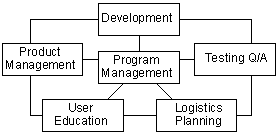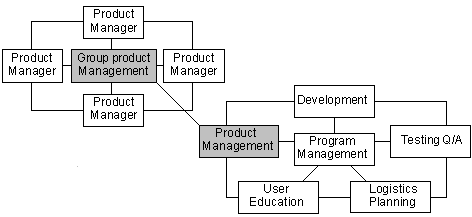
The six team roles identified in the team model are:
You can assign each role to a single individual or, for larger projects, to a team of people with a team lead. For smaller projects, you can give one person responsibility for more than one role.
The following diagram illustrates the relationships among the six project team roles.
Six project team roles

Members representing the various roles participate in the project team as peers, each contributing to a different but equally important piece of the product. The roles are defined in terms of the team's mission, responsibilities, and required skills. Specific responsibilities of each team role are discussed later in this chapter.
Some advantages of building a project organization on such small, mutually-interdependent teams include:
The key characteristic of the team model is very small, cohesive teams staffed with highly experienced, technically knowledgeable leaders and self-motivated team members.
The most effective way to maintain focus is to limit the size of each functional team to three to seven people. If the complexity of the problem requires a larger group for any of the roles, the team leader can decompose the problem into manageable pieces. This level of focus reduces risk and enables the project to be managed more effectively.
The team concept here refers to the lowest unit of coordination. On large projects, it might be a team of developers focused on one small feature set, or a team of Product Managers coordinated by a Group Product Manager who fills the Product Management role in the larger team, as shown in the following diagram.
Small team of Product Managers under a Group Product Manager

On very small projects, however, the entire project might function as a single team.